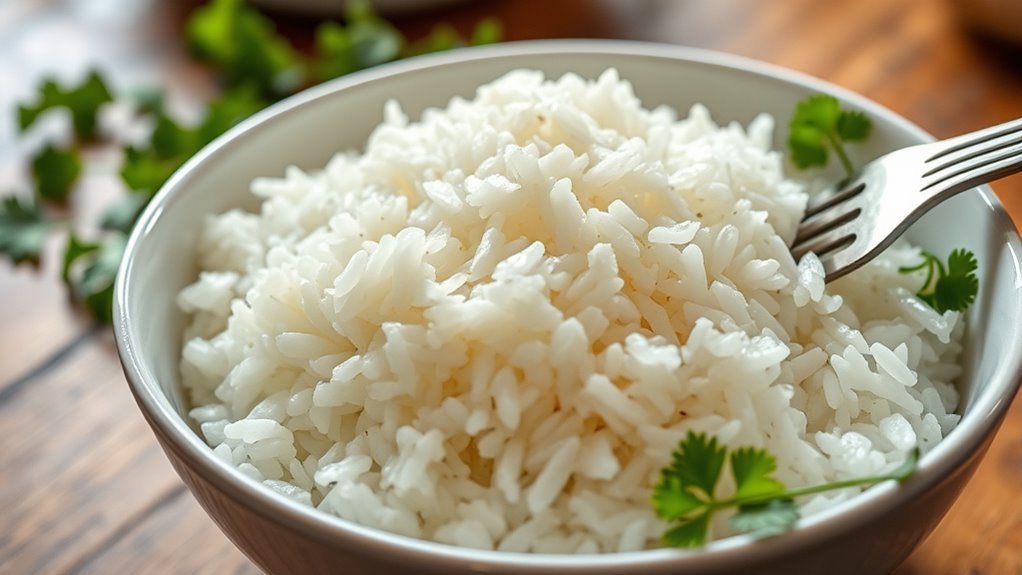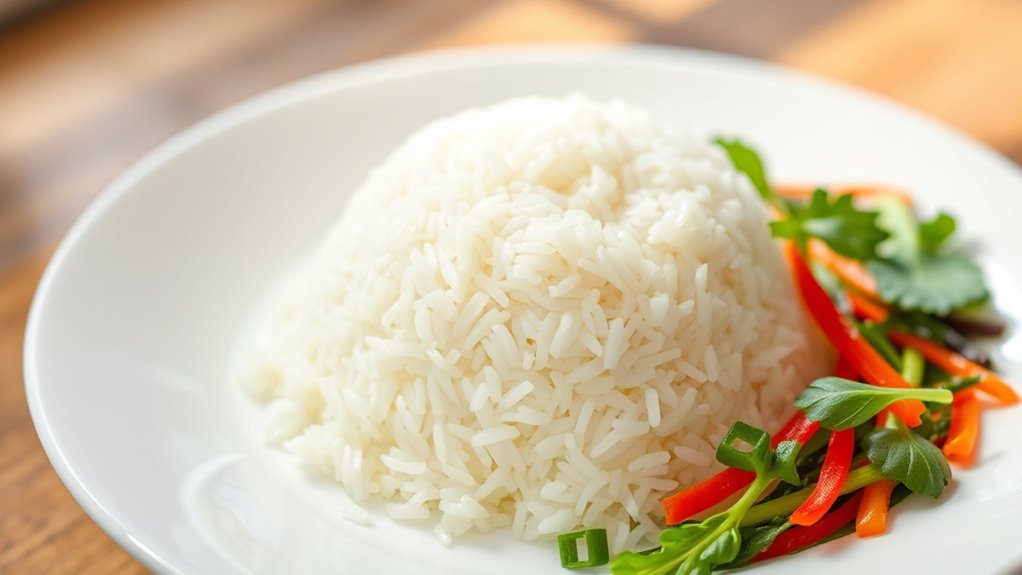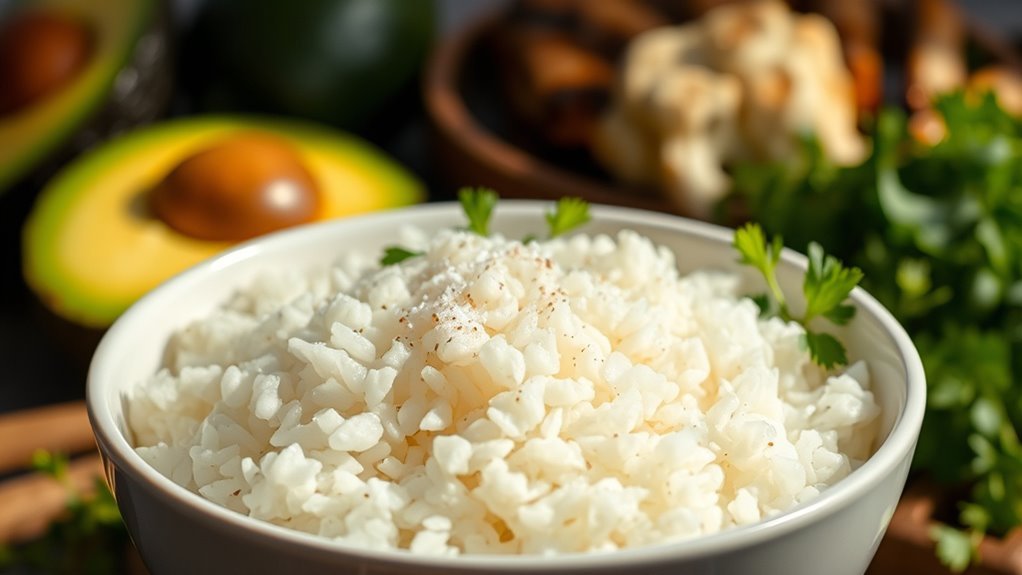Rice isn’t keto-friendly because of its high carb content. A cup of white or brown rice has around 45 grams of carbs, which can kick you out of ketosis. If you want to enjoy a similar texture, consider alternatives like cauliflower or shirataki rice, which have considerably lower carbs. Control your portions and combine with protein or fats to manage blood sugar spikes. There are more options and tips to help tailor your keto journey, so keep exploring!
Understanding the Keto Diet and Its Principles

While many diets promise quick weight loss, the ketogenic (keto) diet stands out due to its unique approach to macronutrient intake. At its core, the keto principles emphasize a high-fat, moderate-protein, and low-carbohydrate dietary framework. This shift encourages your body to enter a state of ketosis, where it burns fat for energy instead of carbohydrates. Following specific dietary guidelines, your carbohydrate intake typically drops to about 5-10% of your daily calories, allowing fats to make up around 70-75%. This can lead to significant weight loss and improved energy levels. However, it is crucial to approach the keto diet mindfully, ensuring you’re consuming nutrient-dense foods that support overall health while enjoying the freedom it offers in meal choices.
Carb Content of Different Types of Rice

When it comes to rice, understanding its carbohydrate content is essential for anyone considering a keto diet. Different rice varieties have varying carb levels. For instance, white rice contains about 45 grams of carbs per cooked cup, making it a poor choice for keto. Brown rice follows closely with around 45 grams but offers more fiber. Jasmine and basmati rice are similar, providing about 45 grams of carbs as well. Sushi rice is also high in carbs, averaging around 53 grams per cup. Wild rice, however, is lower, with about 35 grams per cooked cup. Knowing these differences in rice nutrition helps you make informed choices that align with your keto goals while enjoying the diverse flavors rice has to offer.
Impact of Rice on Blood Sugar Levels

The impact of rice on blood sugar levels is significant, especially for those following a keto diet. Consuming rice can lead to rapid spikes in blood sugar due to its high carbohydrate content. Understanding these rice effects is vital for managing your health. Here are some important points to take into account:
- White rice has a higher glycemic index compared to brown rice.
- Portion sizes matter; larger servings can elevate blood sugar more drastically.
- Pairing rice with protein or fat may mitigate blood sugar spikes.
- Individual responses to rice can vary based on metabolism and overall diet.
If you’re mindful of your blood sugar levels, it’s important to be cautious with rice consumption while steering through a keto lifestyle.
Alternatives to Rice on a Keto Diet
For those adhering to a keto diet, finding suitable alternatives to rice can be a game-changer. Cauliflower rice is a popular choice, offering a mild flavor and low-carb content. Shirataki noodles, made from konjac, are another great option—virtually calorie-free and versatile. If you’re looking for something with a bit of crunch, cabbage rice provides a satisfying texture. Broccoli rice can add a nutritional boost, while zucchini rice offers a fresh, light flavor. Each of these alternatives allows you to enjoy a rice-like experience without the carbs, empowering you to stay on track with your dietary goals. Experimenting with these options can keep your meals exciting while maintaining your keto lifestyle.
Low-Carb Rice Substitutes
Although traditional rice is a staple in many diets, low-carb rice substitutes can help you maintain a keto-friendly lifestyle without sacrificing flavor or texture. These alternatives offer versatility and can be easily incorporated into your meals. Here are some popular options:
- Cauliflower rice
- Broccoli rice
- Zucchini rice
- Shirataki noodles
These substitutes not only provide a similar mouthfeel to rice but also pack in nutrients and fiber. For a unique twist, consider using spaghetti squash or konjac rice. Cabbage rice and eggplant rice are also great choices, adding variety to your plate. By exploring these alternatives, you can enjoy satisfying meals while keeping your carb intake low, giving you the freedom to thrive on your keto journey.
How to Incorporate Rice in a Controlled Way
While rice is generally high in carbohydrates and may not fit into a strict keto diet, you can still enjoy it in moderation by being mindful of portion sizes and meal composition. Start by practicing rice portioning; limiting yourself to a half-cup of cooked rice can help you maintain a balanced intake. Pair your rice with low-carb vegetables and a good protein source to create a satisfying meal that keeps your carb count in check. Experiment with controlled servings throughout the week, incorporating rice into meals where it complements other ingredients. This approach allows you to savor rice’s flavor while adhering to your dietary goals, making your meal plans flexible and enjoyable without feeling deprived.
Nutritional Benefits of Rice
Rice offers a range of vitamins and minerals that can support your overall health. It’s also a potent energy source, providing carbohydrates that fuel your daily activities. Understanding these nutritional benefits can help you make informed choices about including rice in your diet.
Vitamins and Minerals
When considering the nutritional benefits of rice, it is important to note that it provides a variety of vitamins and minerals that can contribute to a balanced diet. The vitamin content in rice plays a significant role in your overall health, while its minerals aid in mineral absorption, enhancing your body’s function. Here are some key nutrients found in rice:
- B vitamins: Essential for energy production and brain health.
- Iron: Important for oxygen transport in the blood.
- Magnesium: Supports muscle function and energy production.
- Zinc: essential for immune function and cellular repair.
Incorporating rice into your meals can enrich your diet with these essential nutrients, promoting better health and well-being.
Energy Source Benefits
As you explore the nutritional benefits of various foods, you’ll find that rice serves as a significant energy source, primarily due to its carbohydrate content. Carbohydrates are essential for fueling your daily activities, and rice provides a quick, digestible form of energy. This makes it especially beneficial for athletes or those with active lifestyles. Additionally, the metabolic benefits of rice include its ability to stabilize blood sugar levels, thanks to its low glycemic index when consumed in moderation. This means it can help sustain energy without drastic spikes or crashes. By incorporating rice into your diet, you can enjoy a reliable energy source while also taking advantage of its versatility in various dishes.
Personalizing Your Keto Journey With Rice Options
When it comes to personalizing your keto journey, exploring alternative rice substitutes can be a game-changer. Options like cauliflower rice or shirataki rice can help you enjoy similar textures while keeping your carb intake in check. Additionally, mastering portion control strategies guarantees that you can still enjoy your favorite dishes without compromising your dietary goals.
Alternative Rice Substitutes
While traditional rice can be off the table for those following a keto diet, there are several alternative substitutes that can help you maintain your low-carb lifestyle without feeling deprived. These options not only mimic the texture of rice but also provide unique flavors and nutritional benefits:
- Cauliflower rice: A popular choice, it’s low in carbs and rich in vitamins.
- Konjac rice: Made from the konjac plant, it’s very low in calories and carbs.
- Broccoli rice: Packed with nutrients, it offers a great alternative with added fiber.
- Shirataki rice: Often called “miracle rice,” it’s low-calorie and helps with satiety.
Exploring these alternatives can enhance your meals while keeping you aligned with your keto goals.
Portion Control Strategies
Finding the right portion sizes is essential for successfully steering your keto journey, especially when it comes to rice alternatives. Practicing mindful eating can help you enjoy your meals while staying within your carb limits. Here’s a simple guide to portion sizes for various rice substitutes:
| Rice Substitute | Recommended Portion Size | Carb Content (per serving) |
|---|---|---|
| Cauliflower Rice | 1 cup | 5g |
| Shirataki Rice | 1 cup | 1g |
| Broccoli Rice | 1 cup | 6g |
| Zucchini Rice | 1 cup | 4g |


